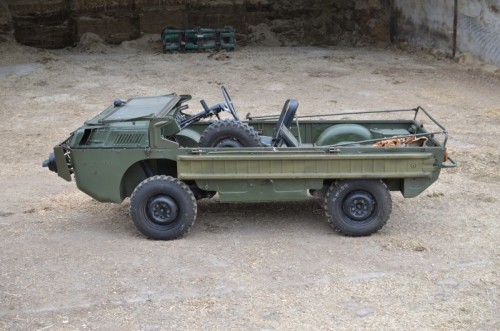
Click Here for Full Screen Image - Click Here to Download Image
 |  |  |  |  | |||||
 |  |  |  |  |
| Lot number | 118 |
|---|---|
| Hammer value | £4,600 |
| Description | LuAZ-967M 4x4 Amphibious Battle Support Vehicle |
| Year | c.1965 |
| Colour | Green |
The LuAZ-967M was a small Soviet four-wheel drive amphibious vehicle, considered by the Russian military to be essential transport on the front line.
Light enough to be air transportable, it had a 400kg payload over most terrain. The design originated after the Korean War, when the Soviets saw a need for small off-road vehicles comparable to the American Jeep, to supplement the overly-large and heavy GAZ-69s then in service. It was to serve for casualty evacuation, munition supply and the carriage of light armaments, proving especially popular with Russian airborne troops and Spetsnaz special forces.
Developed at NAMI (the National Automobile Institute), the prototype, known as NAMI 049, was completed in 1958. It originally featured permanent four-wheel drive with locking hubs and four-wheel torsion bar independent suspension. Unlike the Jeep however, it had a glass-fibre body, but trials proved this to be rather fragile and despite its light weight, the 22bhp motorcycle engine meant that it was rather underpowered. A second prototype, the NAMI 049A, used a coil spring setup to replace the torsion bars and had a (slightly) more powerful 746cc V4 engine, but with a steel body fitted and now weighing 1,350kg, the performance was not greatly improved.
Introduced in 1961 and built at the Lutsk automobile plant (LuAZ) , the production LuAZ 967M had a MeMZ-967A air-cooled V4 petrol engine sourced from the ZAZ automobile, with the relatively modest displacement of 887cc developing 37bhp at 2,250rpm. A four-speed transmission with two ranges gave eight forward and two reverse gears. Unlike many small military vehicles, it was a front-wheel drive 4x2, the rear axle being selectively engaged only when 4x4 was needed.
The watertight steel body had four-wheel independent suspension with coil springs and 11ins ground clearance. The driving controls were on the truck’s centreline and both the controls and the windshield could be folded down for a lower profile. It was able to pull a 300kg trailer, could cross a 58 degree gradient, and had a useful top speed of 47mph. Production ceased in 1975.
On display at the Stondon Museum for several years, this LuAZ comes with a Russian form of logbook which, although is beyond your cataloguer’s small knowledge of the language, does clearly state that it was first registered there in 1989, although it would, of course, have been manufactured much earlier than that. It bears chassis number 010625 and, like all these macines, would have been tested for 100km over land and 2 hours on water before going into service.
There is no other paperwork with this craft but it does look jolly good fun – although hurtling towards you with a crew of heavily armed Spetsnaz aboard it might not be quite so amusing…